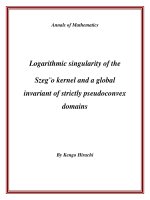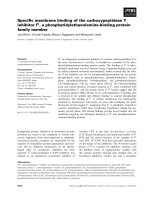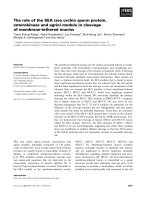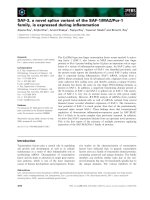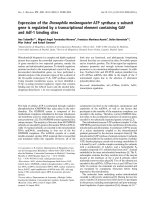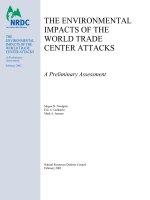Ethnographic accounts of the sathya sai baba movement a spiritual reform oriented movement in singapore identity formation, charity giving rationalization process
Bạn đang xem bản rút gọn của tài liệu. Xem và tải ngay bản đầy đủ của tài liệu tại đây (1.23 MB, 222 trang )
ETHNOGRAPHIC ACCOUNTS OF
THE ‘SATHYA SAI BABA’ A SPIRITUAL REFORM- ORIENTED MOVEMENT IN
SINGAPORE:
IDENTITY FORMATION, CHARITY- GIVING &
RATIONALIZATION PROCESS
NAGAH DEVI D/O RAMASAMY
(B.Soc.Sci.(Hons.), NUS
A THESIS SUBMITTED
FOR THE DEGREE OF MASTER OF SOCIAL SCIENCES
DEPARTMENT OF SOCIOLOGY
NATIONAL UNIVERSITY OF SINGAPORE
2007
i
ACKNOWLEDGEMENTS
This thesis may not have seen the light of the day, nor completed if not for the guidance,
support and confidence placed on the author by some special people.
First and foremost, I wish to thank Associate Professor Vineeta Sinha, my supervisor who
has been extremely supportive of my studies for many years and has guided me during all stages of
completion of this book. Her generous patience, accommodating attitude, encouragement and
assistance in all ways possible especially during the last lap of this Masters course deserve my
earnest gratitude and deference. Her vigilant, quick and detailed comments guided me significantly
in revising my book.
I am also grateful to the following people from the Department of Sociology, NUS- Dr.
Ganapathy Narayanan for his faith in my works and ability; Dr. Eric Thompson and Dr. Leslie
Minor- Evans for their great sense of humour and comments; Associate Professor Tong Chee
Kiong, Associate Professor Lian Kwen Fee and the Graduate Committee for all their assistance.
Besides, I owe my thanks to Dr. Gyanesh Kudaisya (South Asian Studies Programme, NUS); Dr.
Medha Kudaisya (Department of History, NUS) and Professor Joanne Waghorne (Professor of
Religion at Syracuse University, New York) for their interest in my thesis and guidance. The
Department administrative office staffs deserve some mention for all the aid rendered for the
administrative aspects of my candidature. Ms. Raja especially, thank you for patiently obliging to
all the application matters and paperwork I gave you towards the last lap.
The award of the Research Scholarship from the Research and Graduate Division, NUS
and the external research grants from the commissioning agency, Institute of Policy Studies (IPS)
are acknowledged with the deepest appreciation.
A big thank you is fitting for Mr. Vivakanandan Sinniah, CEO of Ang Mo Kio- Thye Hua
Kwan Hospital for sharing his knowledge and experiences, for entertaining our long discussions
on religion and social services, critical insights and timely advises during the period of my research
endeavours. In addition, I owe my debt to Dr. Lai Ah Eng, adjunct Senior Research Fellow at the
Institute of Policy Studies for believing in me and providing me with the timely opportunity for
extending my writings into the Policy Studies arena.
My greatest debt and respect is of course dedicated to the Sai Baba devotees of Singapore,
without whose support, encouragement and enthusiasm, this book could never have materialized.
My enormous debt of gratitude and indebtedness goes out to all my respondents and Sai devotees
of Singapore for their willingness in allowing me to conduct research on their premises and their
consent for interviews. Special thanks to the Sathya Sai Central Organization of Singapore and
the fourteen Sathya Sai Baba Centres of Singapore. In all these places- a core group of
respondents have been instrumental in assisting me in the completion of my fieldwork. My sincere
appreciation and thanks goes out to them.
Friends and colleagues in the NUS Sociology Department have rendered me much
support throughout this journey. My goodwill and thanks goes out to amazing colleagues such as
Shane, Nicholas, Sahoo, Seuty, Asma, Kamal, Grace, Saiful, Fadli, Thomas and Magdalene.
ii
This three- year endeavour would have been an impossibility without the support and
unconditional love of my tight-knit family. Amma, you have been a motivating force throughout
my life. Your virtuous traits that have proved to be pillars of strength for all of us at home are
demonstrated daily without exception. Your tireless patience, love, simplicity, silent support,
espousal of my higher education, understanding and your sacrifices held me through this arduous,
wearisome, at times even questionable period of my life. During the frequent temporary
melancholy spells I find myself falling into, it has been your thoughts and your exemplary
performance of motherhood that have enabled me to get up and move on, to deliver this literary
product for you, for all that you have done for me. I love you, amma.
My two elder brothers Loga and Siva, I owe my gratitude for their encouragement and
belief in my educational pursuits and their sincere and forthcoming help in everyway possible
especially in rendering transport help during those rushing, tiring days. Loga Anna- special thanks
for allowing me access to your car those late nights when I simply needed to get away from the
stresses of my writings and be alone at my secret hide- outs to cogitate. Siva Anna- thank you for
your quiet moral support and the nightly supper delights. My sister-in-law Gayathri- in whom I
have found a sister and a dependable friend who provides me with encouragement, advices and a
listening ear during those crucial moments when I just needed to get everything out of my system
and I never had a need to look further than three doors away. Your care- free, patient and neverfail- to amuse- me comical character has elated me on various occasions.
I have been fortunate in coming across many witty and good friends, without whom life
would have been bleak and without purpose. Special thanks and sincere acknowledgements are
addressed to:
Subra- for those crucial part- time job referrals that helped me figure a way out of my
financial crisis during the last two months as well as gain immense exposure and experience in
youth pedagogy through conduct of enrichment programmes. Vani- my trusted crony, for the
sympathetic ear and dependable comradeship in the last one year. Kumeresh and Bala- for the
enthusiasm shown towards my research and motivational short text messages and talks during
those times when I was on the verge of giving up. Ramesh- for your faith in me. Sashi- for your
constructive comments. Sathis- for your prayers. Rathi - my chum, for your constant thoughts and
concerns even while we are separated by distance. Deva- my fellow Piscean buddy for just
believing in and encouraging me in all my pursuits without question nor doubt. And finally
Kumeresh- I am truly indebted to you, for taking the trouble to resuscitate my hard disk that
‘crashed’ during the final week of submission (well yes it did eventually go into permanent braindamaged mode after a while!) despite your superbly busy schedule- you saved all my precious
fieldwork interview files and illustrations! Special thanks for the help with the plates too. This
book could never have made it on time if not for your timely assistance. There are many others,
whom I have not mentioned due to space constraints but your moral support has not gone
unnoticed. Thank you as well.
Not forgetting the well- wishes of my tutee Megala (thank you for those constant flow of
re-mixed mp3 Indian music and home- cooked spreads during lessons!), my Siling & Evergreen
primary school angels for their innocent high- pitched enthusiasm and my Fuchun CC Mentee
group- all eight teenagers of whom have expressed their faith and encouragement in the successful
iii
completion of my book. I look forward to the outings we have, where your enthusiasm and youth
spirits uplift and invigorate me every single time.
Dear Venka, you have begun to play an instrumental role in my life. Your guidance, love
and faith in my ability have helped me finish this book. I am truly grateful for your affection and
emotional support in all my endeavours.
Last but not least, a special little being deserves some credits here. The newest entry in my
family-my niece Thrisha a.k.a Vandu also my thesis’s one and only aficionado, I like to think! It
has been more than a year now, but your birth has been the herald of many blissful moments of my
life. The acts of changing diapers- dressing- singing of the lullaby to- play-times- our time spent
alone during baby- sitting affairs (I was actually surprised at your genuine efforts to listen and
make sense of my private droning)- and the frequent ritual of putting you to sleep- had brought
moments of content and served as a natural healing and soothing remedy whenever I felt mentally
drained after fighting with data (or the absence thereof). Your beautiful chuckles, futile out- oftune singing attempts, acts of comedy and cute maladroit dawdling steps had been my source of
encouragement and laughter. Your companionship during those stressful moments is cherished. At
least I knew I was not alone ☺! You are constantly leaving ‘wet’ special imprints and smiles in my
life, not forgetting the visible marks you left after hammering my laptop with your little hands ☺ !
I dedicate this work to the two instrumental women in my life: Amma and little Thrisha.
I am solely responsible for the contents of this book, including any errors that may be present.
Nagah Devi Ramasamy
iv
TABLE OF CONTENTS
1.1
1.2
1.3
1.4
1.5
ACKNOWLEDGEMENTS
SUMMARY
LIST OF TABLES
LIST OF FIGURES
LIST OF PLATES
GLOSSARY
i
vii
ix
x
xi
xii
CHAPTER 1: INTRODUCTION
Setting the Scene
Statement of Research Questions
Significance of Research Questions
Review of Literature
Analytical Framework and Organization of Thesis
1
3
7
9
16
2.3.1
2.3.2
2.4
2.5
2.6
2.6.1
2.7
2.8
CHAPTER 2: RESEARCH METHODOLOGY
The Research Process
Site Selection
Informant Selection: Organizational Channels and Informal
Mediums
Structure
Informant Selections and Channels
Data Collection
Socio- Demographic Profile of Informants
Methodological Issues and Limitations
Obstacles to Gaining Access
Researcher Confronting Issues of Subjectivity and Objectivity
Summary of Research Design
3.1
3.1.1
3.2
3.3
3.4
3.4.1
3.4.2
3.4.3
3.5
CHAPTER 3: THE RESEARCH SETTING
Historical Background
The Founder and his Charisma
Profile of the Sathya Sai Baba Movement in Singapore
Religious and Cultural Characteristics
Programmes and Activities
The Spiritual Wing
The Education Wing
The Service Wing
Summary
2.1
2.2
2.3
19
24
25
25
28
29
31
34
34
39
41
43
43
51
52
56
56
64
72
77
v
4.1
4.2
4.3
4.4
4.5
4.5.1
4.5.2
4.5.3
4.5.4
4.6
4.7
4.8
CHAPTER 4:
SATHYA SAI BABA MOVEMENT:
COLLECTIVE IDENTITY CONSTRUCTION EFFORTS
Introduction
Singapore Race- Religio- Politico Developments
Hindu Religious Change
Why Turn to Sai Baba?
An Inclusive Structure
Space
The ‘Hindu’ Label as Problematic
Realm of Gastronomy
A Plural Community
Reflections on the Bhajan Ritual
The Sai Family as a Global Entity
Summary
79
81
89
90
96
98
104
105
107
112
115
116
5.1
5.2
5.3
5.3.1
5.3.2
5.4
5.4.1
5.4.2
5.5
5.6
CHAPTER 5:
CHARITY: IDEOLOGY OF HUMANISM
VOLUNTEERISM: YOUTHS IN ACTION
Introduction
History
The Singapore Model that Works
Present Scene
Religious Bodies and Welfare
Sai Philosophy of Humanism
Performance of Seva
Socio- Religious Inclinations
Youth Participation
Summary
117
117
118
120
121
122
123
125
135
138
6.1
6.2
6.3
6.4
6.4.1
6.4.2
6.4.3
6.5
CHAPTER 6:
RATIONALIZING CYBER- SPACE SAI SPIRITUALITY
Introduction
The Technocratized Network
Virtual Community
Sathya Sai Baba Movement in Cyber- Space
Bhajans
Digitization: Sai Baba Images and Videos
Negative Publicity on Cyber- Space
Limitations of Cyber- Related Research
139
139
145
148
148
154
158
162
vi
6.6
Summary
163
7.1
7.2
7.3
CHAPTER 7: CONCLUSION
Introduction
Making Sense of the SSB Movement
Limitations of Study and Recommendations
164
164
169
BIBLIOGRAPHY
APPENDICES
TABLES
174
190
206
vii
Summary
Title: Ethnographic accounts of the Sathya Sai Baba- a Spiritual
Reform- Oriented Movement: Identity Formation, Charity- Giving &
Rationalization Process
This research is an ethnographic study of the Sathya Sai Baba (a global neospiritual) Movement and its various centres in Singapore. Faith becomes a matter of
personal preference during the up rise of modernity and intensive urbanization, especially
when the authority of traditional religious institutions weakens. People embark on a
search for a common identity and spiritual enlightenment often through experimentation.
The participation of a large proportion of multi- ethnic and multi- religious
devotees is noticed in the local manifestation of the movement. The movement’s facility
in promoting a multi- ethnic and multi- religious communal identity amongst its
membership is interesting in the host city of Singapore. The SSB movement once
imported into Singapore, has adapted itself to and revised certain modes of its operations
and practices over time to assimilate itself to the needs of the multi- racial devotees as
well as learnt to co- exist in harmony with the state’s policies. The thesis addresses the
question of why people of different ethnicities and religious orientations join the
movement and the processes of establishing a collective identity.
Secondly, particular attention is in addition devoted to the movement’s created
‘imagined community’ and their participation in charitable activities as a united group
and how devotees are mobilized from the spiritual realm to expand their expertise into the
social service realm. Specifically, what are the socio- religious inclinations in the
promotion of charitable activities in the movement?
viii
The internet has become a domain of engagement for purposes of experimentation
and experiencing. Cyber- space as a transnational socially constructed nexus for a Sai
virtual community and how the local movement approaches and rationalizes devotion
over the web is explored last.
These questions are analysed with an ethnographic gaze, supported by some of
Weber’s social action theory and Durkheim’s collective consciousness frameworks.
ix
List of Tables
Table 1:
Resident Population Aged 15 years and over by Religion
206
Table 2:
Resident Population Aged 15 years and over by Ethnic Group
and Religion
207
x
LIST OF FIGURES
Figure 1:
Figure 2:
Figure 3:
Logo of International Sai Organization
Sarva Dharma Logo (old)
Sarva Dharma Logo (new)
55
55
56
xi
ILLUSTRATIONS
1.
2.
3.
4.
5.
6.
7.
8.
9.
10.
11.
12.
13.
14.
15.
A ring, SSB materialized
Multi- Religious God- heads in a typical devotee’s domestic
altar
SSB’s Chair with his robe framed up
Below- Photo of SSB’s feet
A SSEHV Class
SSEHV Gurus
Centre devotees playing games during seva activity
A Centre President doing seva at Sun Love Home
An altar at a centre
SSB altar in a Chinese devotee’s house
A Chinese couple offering arathi during a CNY Home bhajan
A chair placed near the altar for SSB
A CNY bhajan at a devotee’s house
Devotee engaging in conversation during CNY seva activity
Serving food during seva at Sun Love Home
A short prayer session before seva activity
44
58
60
69
72
74
77
100
102
109
110
113
126
131
135
xii
Glossary
Ahimsa: Non- violence
Arathi: Hindu ritual in which camphor flame is offered to deities
Ashram: Abode
Avatar: An incarnation
Bhajan: A song of devotional love, from a root related word Bhakti. It is sung to the
accompaniment of musical instruments on traditional themes and may be chanted in
temples or other public gatherings
Bhakti: Derived form the root bhaj, “to love, worship or adore”, signifies attachment,
devotion, fondness for, homage, worship, piety and faith
Brahma: Name of one of the gods of the Hindu Trimurthi or Trinity; also the Creator
Darshan: Sight of the divine
Devi: The generic name for “Goddess”
Dharma: From root “Dhar”, “to hold, bear support, maintain, preserve”; also refers to
law. When applied to the individual, it has reference to that code of conduct that sustains
the soul, and produces virtue, morality or religious merit leading towards the
development of man
Ganesha: The god of knowledge and the remover of obstacles
Gayatri Mantra: Highly revered mantra in Hinduism
Guru/ Swami: Dispeller of darkness or heavy with wisdom
Kaliyuga: Age of iron
Karma: From the root kar, to do, make or perform. An act or its performance,
irrespective of purpose. In Brahmanical literature karma means “the practice of religious
duties”, particularly those relating to sacrifice and performed solely to ensure divine
favours. Later such action was designated karma- marga defined as an action that is
intentionally good or bad, and identified with dharma as an expression of the kinetic
process to which all phenomena are subject
xiii
Kartal: Pair of wooden blocks or frames with small metal jingles mounted on them and
beaten together to produce a rhythmic support for bhajans
Krishna: Krishna is worshipped as an avatar of Vishnu
Kshatriya: Warrior caste
Kuan Yin: Chinese Goddess of Mercy
Lingam: The Hindu phallic symbol of Lord Shiva in Hinduism
Mandapam: Hall
Mantra: From the root “man”, signifies “to think”, “instrument of thought”; the ideal
inaudible sounds constitute one aspect of the universe and when visualized or written as
letters, or vocalized as syllables, constituting a universal terminology; also that portion of
the Vedas which contain songs to the praise of gods
Mridanga: Percussion instrument; a rhythmic accompaniment during music ensemble
Murugan: Son of Lord Shiva and the chief deity of the ancient Tamils of South India who
later became identified with the Hindu God Skanda
Nagasankirtan: Morning devotional songs
Om: Sign of Hinduism
Prasada: Consecrated food given to the worshipper in a temple
Perumal: Another name for Vishnu, in the South Indian tradition
Prema: Love
Puja: Act of showing reverence to a God
Sadhana: Means of attainment
Saivism: Name given to the teachings and practices of devotees of Lord Shiva. Saivism is
particularly strong in Southern India. It also flourishes in differing styles in Kashmir and
Bengal
Salwar Kameez: Traditional dress of South Asia
xiv
Sannyas: Hermits
Sarva Dharma: World religions
Sastric: Classical text
Satsang: Devotional speech and chanting programs for the upliftment of the divine love
consciousness of a devotee
Sathya: Abstract noun from sat, ‘to be’; truth
Seva: Service, referring to the only activity permitted to the Shudra caste, and an activity
from which all Brahmins are prohibited from engaging in
Shanthi: Peace; the term has always had a religious connotation; it is the peace known to
one who has realized absolute reality
Shiva: “Auspicious”, also the God of Ascetics, of the linga and of cosmic destruction as a
second member of the Hindu trinity
Swami: Hindu honorific title for either males or females. A title added to one’s name to
emphasize learning and devotion to god
Tua Pek Kong: He is one of the pantheons of the Malaysian Taoist Chinese Gods
Vaishanavism: Name by which the teachings of the followers of Lord Vishnu are known
in Hinduism
Vedas: Sacred divine scriptures amongst the most ancient
Vibuthi: Sacred ash
Vishnu: Name of one of the gods of the Hindu Trimurthi or Trinity; the Preserver
Yugic: Age Cycles
1
1
INTRODUCTION
1.1 Setting the Scene
‘Our world is what it is today because humans are selfish, egoistic,
vengeful and arrogant. We covert all that is shiny and materialistic. Our
pursuit of the materialistic has made us lose sight of our humanity [...]
In Taoism, the search for peace and harmony lies with man. Man
decides for better or worse.’ (Master Lee Zhiwang, President of the
Taoist Mission Singapore)
(From Special Report ‘World with no peace? World with no Joy?’ The
Straits Times December 23 2006)
This extract from a newspaper article demonstrates the fragility of religiosity and
religious behaviour in the contemporary world. The emphasis on maintenance of peace
highlights the moral underpinnings of human actions. Early anthropologists and grand
theorists devoted much space to the study of religion, as it has been one of many
compatible lenses to understanding human actions. Religious texts and doctrines embody
not merely positive moralistic philosophies but more significantly urge the audience to
reflect on their lives and to improvise and align them with the changing needs of the
wider society. The poignant title of the above article illustrates the possibility of a
morally disintegrating world. Religion is desired as a sanctuary to revive the declining
moral condition of the civic space. This urgent call to pay attention to world events that
are faltering the order of the moral condition is not to be brushed aside as a hyperbole.
The ecological calamities including the human-induced ones that we have seen
around the globe and experienced through the media are only a small part of the story.
2
How people in actuality have come to terms with the events, their responses to them and
the effect the events have had on them are conditioned by the cultural and religious
milieus of the community.
Engaging this train of thought, a fundamental observation in the sociological
study of religions in modern society relates to the rise of New Religious Movements
(NRMs), New Spiritual Movements (NSMs) and cults1. Many scholars have attributed
this phenomenon to the decline or the gradual secularization of traditional religions like
Christianity (Nelson 1987; Johnstone 1997). History may have envisaged that religion
has relentlessly come into focus as a struggle between the good old forces of
institutionalized churches and disorder- seeking sects and cults. However, an intermediate
ground- seeking innovation has been casting its shadow whilst the writings of the
dominant discourses inspired by religious fervour continue. Carrying the popularly
coined brand name of NRMs, they have long been in existence despite recent writings on
them. Beckford (1987) writes that the idea of a NRM implies a structured attempt to
introduce changes in religion (p. x). Often reformist in orientation, the term ‘movement’
can be said to denote shifts in people’s religious beliefs, ideas and conceptions which
they were so used to in older organized religious orientations.
Marshall (1994) points out that NRMs often tend to be syncretistic in nature,
borrowing elements from many different religious and philosophical traditions.
Sociologists in addition have made claims that such movements satisfy the psychological
and social needs of young and modern people seeking a meaning in life, something they
1
Terms NRM and NSM are used in conjunction with reference to the Sathya Sai Baba movement in the thesis.
3
often fail to find easily within mainstream religious traditions. More often than not,
adherents refer to them as movements gracing the spiritual genre and call them spiritual
movements.
The religious economy thesis has dominated the discursive field of religion in the
field of sociology with much success in the study and analysis of religious and cult
movements in the United States and Canada (Stark and Bainbridge 1985). However, it
has been unable to account for the global spread of other spiritual movements such as the
Sathya Sai Baba (SSB) spiritual movement. “The religious economy thesis primarily
lends itself to Christian and Western discourse. What is evident here is the operation of a
Eurocentric bias with regards to western exclusivist and religious conversion” (Pereira
2005: 1).
1.2 Statement of Research Questions
What has sparked interest in these NRMs and led to their immense popularity? Is
the rise of NRMs indicative of complete religious decline or merely signals religious
change? Are we witnessing merely a transition from faith to secularity? Or does it engage
with a much deeper concern with abandoning moribund official, ‘church’ religion in
favour of adopting ‘unchurched’ spirituality? There have been several conceptual
developments in the field of new religions and new spiritualities and they have been finetuned and theorized repeatedly by several (i.e. Clarke 2000, 2006; Campbell 1999;
Heelas and Woodhead 2005; Hexham and Poewe 1997; Stark and Bainbridge 1985; Stark
et al. 2005 and Wilson 1993 amongst many). There are many groups within the new
religions (some fraudulent while some genuine). It has been noted that all tend to
4
experiment with alternative life- styles, philosophies and religions, often Eastern in origin
and practice new psychological and physical therapies. These groups although not always
in broad agreement are largely concerned with discovering new paths to world peace. All
strive to awaken the self to attain higher consciousness. The current state of research in
this realm have deduced the following conclusions concerning the pull factors of NRMs
and NSMs over that of older religions as demonstrated below in Clarke’s (2006) latest
work.
People welcome spiritual movements with open arms firstly due to the
experiential learning and emotive processes associated with them. Many approach the
direct attainment of religious experience with contentment due to the possibility of
gaining self- realization much quicker and through individually tailored means.
Interpreted another way, this is known as the ultimate self- transformation process. This
form of experiential approach leading to spiritual advancement is preferred over creedbased religion, the latter that is considered slow and known to not give much autonomy to
the self in decision- making. Secondly, the players in the movements most often get to
practice autonomy in management of their own spiritual advancement or the consequent
de- emphasis on the significance of the role of the clergy as found in most waning state
religions. This in turn translates into increasing individualism of the self.
Thirdly, spiritual movements often fuse psychology and religion with the motive
of uncovering the ‘true self’ and by virtue of this trait are labelled as ‘new’ or
‘innovative’. Hybridity is another key characteristic. Different aspects of different
traditions (both sacred and secular) are integrated within the movement thereby leading to
5
the possibility of co- existence of different faiths. This sets the scene for the ideology of
multiple belonging and retaining of the birth religious identity. This potentially
demonstrates an inclusive structure that accommodates the values of the existing social
order. Fourthly, there are often traces of ritual and ideological changes. Major religious
innovations are shown in modified practices and mannerisms in which beliefs are
understood and interpreted. Fifth, there are organizational differences. Secular forms of
managing the administration and assembly together with adoption of modern modes of
communication and networking in the secular mode- stand in stark relation to the
established traditional norms in mainstream religions.
Based on these conclusions I say with confidence that we are certainly not
witnessing religious decline but rather a change- an adaptation in existing faith systems to
fit the changing needs of man and society, to align religious innovations to social and
historical conditions. Most modern spiritual movements adopt subjective spirituality
whose ultimate endeavour is to engage and deal with matters of self- transformation. The
SSB movement is one movement that has taken such a form in Singapore and reveals a
close fit to the above- mentioned model.
This thesis seeks to answer important questions about the growth of NRMs
through a nuanced sociological understanding of the SSB movement, a movement that
has by now established itself globally. Its sheer popularity (basing upon the membership
numbers) in comparison to other movements and its active engagement with the public
seemingly distinguishes it from the rest, observations that require analysis and
explanation.
6
SSB who proclaims himself to be the reincarnation of the Moslem mystic Sai
Baba of Shirdi (1856- 1918), is a noted ‘miracle worker’ with millions of disciples in
India and internationally. Drawing from the Hindu traditions of sannyas, he wears orange
robes and his teachings derive primarily from Hindu philosophy amidst assertions and
claims of the movement’s affiliation to diverse religious and spiritual traditions. Thus far,
his teachings have not given rise to any international controversy and no hermetic aspects
noted. In light of the importation of the movement in a locale distant from its country of
origin, several important thematics and problematics require sociological analysis and
interpretation. Through my thesis research, I attempt to provide some answers to these
three central questions:
(1) What specific socio- cultural conditions enable the growth of this multi- ethnic
reform- oriented spiritual movement in Singapore? Additionally which are the
specific realms in which a sense of communal identity consciousness is observed?
(2) Why and how does the SSB movement mobilize its devotees to engage in social
service? What are the significant socio- religious inclinations in the promotion of
charitable activities especially amongst the youths?
(3) How has the movement contributed to transnational spirituality, particularly in the
realm of cyberspace? How have the local devotees rationalized Sai spirituality in
this realm?
The next section situates these questions within the phenomenon of NRMs and
explains the significance of these questions to the Singapore context.
7
1.3 Significance of Research Questions
Multiracialism and multiculturalism as significant ideological concepts for
Singapore’s progress have been documented widely. New religions have increasingly
taken on the task of tailoring their teachings and practices to achieve congruity between
themselves and the ever- changing cultural context on which they have settled at (Wilson
and Cresswell 1999). The SSB movement once imported into Singapore, has adapted
itself to and revised certain modes of its operations and practices over time to assimilate
itself to the needs of the multi- racial devotees as well as learnt to co- exist in harmony
with the state’s policies.
Agreeing with Pereira (2005), literature on NRMs have limited themselves to
discussions of NRMs and their international travel but not offered any detailed analysis
on how they proceed after the initial foothold has been established in the host countries
(ibid). This movement is growing in numbers globally, and it is no exception in
Singapore. There are some specific socio- cultural conditions that enable the maintenance
of this trend of increasing numbers.
The first research question seeks to find out what are these specific conditions that
encourage the movements’ popularity. In addition using devotees’ narratives I seek to
demonstrate the particular everyday realms and the activities therein through which a
common sense of Sai identity operates and is maintained. “Networking rather than a
focus on religion as a community tends to characterize modern religion” (Clarke 2006:
13). The thesis question is- how do Sai devotees network in unison to contribute to the
8
success of the movement as well as to strengthening of ethnic and religious ties via the
spiritual mode.
All religious movements seem to be characterized by some prospects of salvation.
Service to others is found to a greater or lesser extent in majority of the movements.
Various welfare initiatives in the profane realm demonstrate these movements’ altruistic
potential. Adherents of such movements are not ‘brainwashed zombies’ as commonly
termed by anti- culturalists and the media (Wilson and Cresswell 1999) but in fact stand
out as motivated individuals who possess the capability to rationalize and intellectualize
their decisions. The SSB movement stands out due to the extent of involvement with
social works. It can be essentially classified as a religion of humanity that regards
doctrine and dogma as secondary to action. Sai devotees hold service of humanity to be
the highest good and the true essence of spirituality.
The second question this thesis then poses is this: how does the movement
mobilize devotees to participate actively in this realm? How does the movement convince
its ‘initiates’ to place as much importance on the profane (social service) aspect as on the
sacred (spiritual) aspect? This is an important realm of investigation for religion is a good
source of social support for a country, especially in states such as Singapore that does not
support ‘state welfarism’. The realm inevitably also springs an explanation to the notion:
Is charity- giving a potential politically viable strategy to promote the movement to the
public?
Qualitative and analytical writings on religious and spiritual expressions in the
medium of cyberspace are not novel, but they are still relatively new projects
9
analytically. For one to fully appreciate the impact of a sacred phenomenon in its own
right, it must be understood in the context of a global society (Clarke 2006). The
employment of technology and reliance upon it in the Sai worship mode is an interesting
arena of investigation as cyberspace plays a significant role in accelerating spiritual
transformation and transmission.
This glocalizing tendency- the ability to transfer oneself to a different locale and
become open to moulding by the local processes, can contribute in numerous positive
ways in which the sacred space confronts the disintegrating forces of modernity.
My last thesis question confronts issues of hierarchy and egalitarianism on the
net and democratization of religion through the medium of cyberspace. After all,
Cyberspace has the potential to aid in the transnational spread of religion and help
institute displaced communities as well as enable processes of democratization.
1.4 Review of Literature
NRMs or NSMs are typically characterized by several levels of memberships, the
ability to adapt to the cultural milieu they have moved into and an inclusive structure that
accepts adherents of all sorts of ages, occupations, classes, ethnic groupings and
educational attainments. Given the popular interest in the presence of NRMs, analytical
work on the subject is of great relevance to society at large. NRMs taking on varied
forms have succeeded and failed for various reasons. Charismatic guru- based forms of
worship especially started becoming a popular phenomenon in the 1970s and 1980s
within the climate of counter- culture movements. God- persons, both men and women
10
hold a notable position in contemporary Hinduism. Many such movements have been
imported into Singapore and passed their peak or ran out of momentum.
The SSB movement is one case that has seen significant growth in the last three
decades amidst growing controversies and disagreements regarding the authenticity of the
man. There is an urgent need to re- visit this glocal movement which was last studied indepth in an unpublished treatise (see Santhosh 1997). Since then, there have been visible
changes. The centres have expanded, memberships increased, novelties introduced in
worship modes, and activities expanded and extended. In addition, certain taken- forgranted conceptual issues associated with the movement have been brought to the
forefront recently. With increasing numbers of centres practicing autonomy and voicing
the need to distinguish themselves from religion as a category and from other similar
movements, certain distinctions are having emphasis upon them.
There are both local treatises as well as international academic writings on the
SSB movement (see Babb 1983, 1986a, 1986b; Bassuk 1987; Bharati 1970; Bowen 1988;
Brent 1972; Clarke 2006; Ellison 1981; Harper 1972; Hummel 1985a, 1985b; Kent (2000
a- b), 2004, 2005; Klass 1991; Lee 1982; Palmer 2005; Sharma 1986; Spurr 2003;
Srinivas 2001; Swallow 1982; Taylor 1984; Urban 2003 and White 1972).
The literature review incorporates some analysis on relevant cross-cultural
research conducted on the SSB movement with specific attendance to the raised research
questions. While it is acknowledged there are voluminous literatures on SSB movement,
the works vary from some good analytical academic works to very descriptive historical
materials as well as hagiographical and promotional writings. It is beyond the scope of
